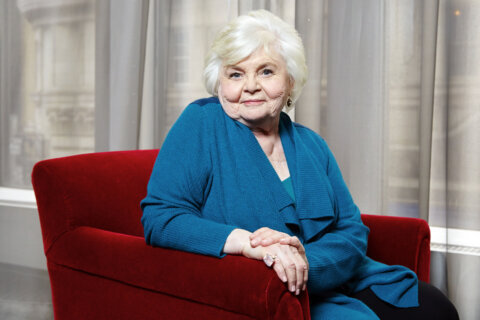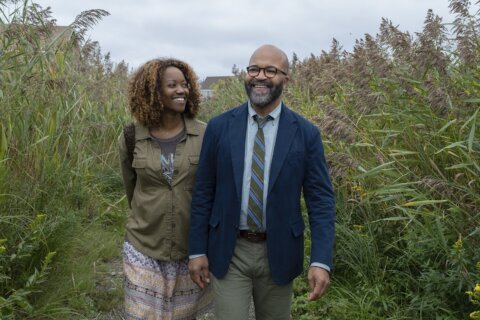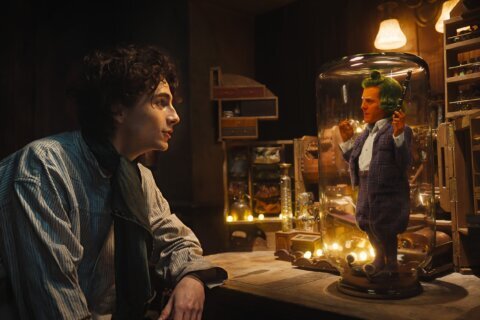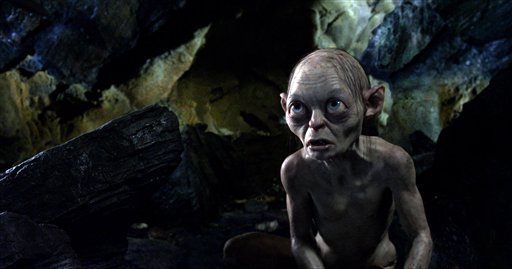
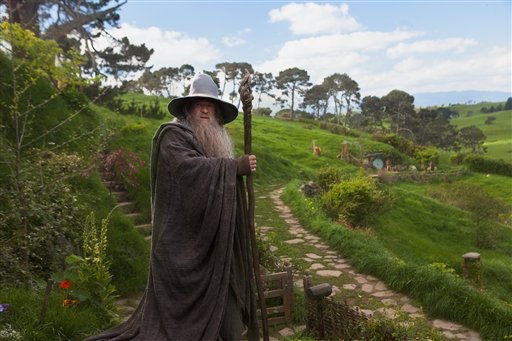
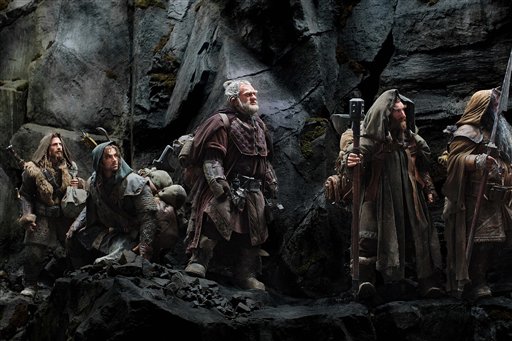
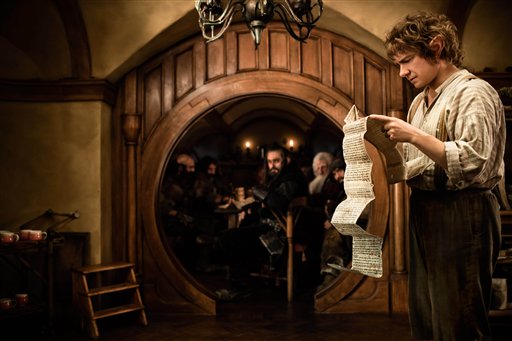
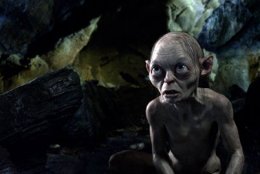
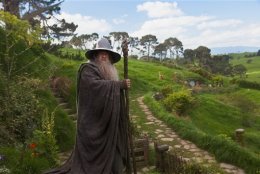
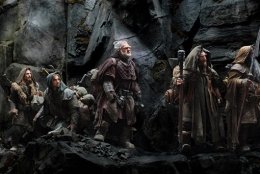
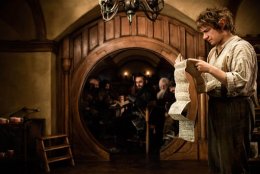
Jason Fraley, WTOP film critic
SILVER SPRING, Md. – Rubbing their eyes and recycling their 3D glasses, two young women debated “The Hobbit: An Unexpected Journey” as they left the Majestic 20 in Silver Spring.
“That made absolutely no sense,” one said, glad that her “other worldly” experience was over after three hours.
“It made total sense to me,” the other said, mounting a defense for her beloved Middle Earth franchise.
This is the best way to sum up Peter Jackson’s prequel from a book many of us read in middle school.
Diehard “The Lord of the Rings” fans will get goose bumps from the familiar music and smile with each returning character. And why not? These are reminders of a masterpiece saga: “The Fellowship of the Ring” winning four Oscars and becoming the newest movie on the AFI Top 100; “The Two Towers” winning two more Oscars; and “The Return of the King” winning 11 Oscars, tying “Ben-Hur” and “Titanic” for the most in history, and joining “The Godfather II” and “The Silence of the Lambs” as just the third sequel to win Best Picture.
But past accomplishments only get you so far. Those walking fresh into “The Hobbit” may find it an arduous journey with plenty of dead time. Much of this is due to the decision to divide J.R.R. Tolkien’s “The Hobbit” into three movies. This made sense for the “LOTR” trilogy, where three books (398, 327 and 412 pages) were turned into three movies, while “The Hobbit” turns a single book (310 pages) into three, three-hour flicks.
The plot is framed by an elderly Bilbo Baggins (Ian Holm), who writes his life story for future generations. We dive 60 years earlier to see Bilbo as a young hobbit (Martin Freeman) living in the Shire. One day, the kind wizard Gandalf the Grey (Ian McKellen) invites a team of 13 dwarves to Bilbo’s house to plan a journey to the Lonely Mountain to reclaim the lost Dwarf Kingdom of Erebo from the evil dragon Smaug. Bilbo reluctantly joins their voyage across Middle Earth, needing to prove his worth to the team’s leader, Thorin Oakenshield (Richard Armitage), the target of a revenge plot by a one-armed Orc warrior. His best hope lies in a magical gold ring that drops from the pocket of the underground creature Gollum (Andy Serkis).
Gollum is just one of the film’s many familiar faces. Ian McKellen is back as Gandalf, playing as lovable a father figure as we remember, but his face looking much older despite the fact it’s supposed to be 60 years earlier. Cate Blanchett and Hugo Weaving respectively return as elves Galadriel and Elron, master of Rivendell, providing a roundtable discussion with McKellen and Christopher Lee, who returns as Saruman (before his turn to the dark side). There’s even a brief appearance from Elijah Wood as Bilbo’s nephew Frodo, who walks around the Shire in the opening framing device.
Still, Serkis steals the show as Gollum. You’ll have to wait a while to see him, but when he finally crawls out of the shadows, expect clapping in the audience. Here, he plays a riddle game with Bilbo with high stakes: if Bilbo wins, Gollum will show him the way out of the tunnel; if Gollum wins, he gets to eat Bilbo. As the schizophrenic creature shifts back and forth between the trixie Gollum and the adorable Smeagol, we’re reminded why he’s one of the most precious movie characters of all time.
Unfortunately, Jackson doesn’t create NEW characters to fall in love with, especially in the hero’s entourage. In the original trilogy, Frodo had Samwise Gamgee (Sean Astin), Merry & Pippin (Dominic Monaghan and Billy Boyd), Legolas (Orlando Bloom) and Aragorn (Viggo Mortensen). In “The Hobbit,” the only memorable teammate is Thorin, a dwarf of royal lineage. The rest of the dwarves fade into the background, possibly because they survive every peril thrown at them. There are no death moments like “Saving Private Ryan” to cement them in our memory, and enough “deus ex machina” to limit the feeling that they’re ever in any real danger.
Instead, the best “character” remains the score of Howard Shore, whose prior renditions won him three Oscars. As the Shire woodwinds dance across the soundtrack, the magic of “The Lord of the Rings” comes rushing back. The same goes for the visual effects, as Jackson again dazzles us with the perspective tricks he perfected in the original trilogy, allowing actors to appear tall and small simultaneously in the same room. The video game visuals bring us giant trolls around a campfire, giant rock creatures headbutting each other, and a flock of majestic eagles saving the day. Some have complained of motion sickness from Jackson’s frame rate, which runs twice as fast at 48 frames per second, but I didn’t have that problem. My issue is with the STORY rate.
The script’s lack of discretion is disappointing, considering it was co-written by Jackson, Guillermo del Toro (who bailed as director in 2010) and Fran Walsh and Philippa Boyens (who co-wrote the original trilogy). The project was first envisioned in two parts, but was expanded into a trilogy of prequels: “An Unexpected Journey” (2012), “The Desolation of Smaug” (2013) and “There and Back Again” (2014).
The result is plenty of filler material across 2 hours 46 minutes. The story takes forever to get going, spending entirely too long watching the dwarves sing and carouse in the Shire. The first 40 minutes could be collapsed into a 10-minute setup, with Gandalf’s arrival serving as the catalyst into Act Two. The delay prevents the film from being “an unexpected journey,” feeling instead like an all- too expected journey that takes forever to happen. As the film ends with the Lonely Mountain far in the distance, we wonder why we’ve gone through so much and still have only made it this far.
Cynics will claim this as another example of Hollywood sacrificing story for box office receipts, while Jackson claims there were merely too many story beats in Tolkien’s book. Either way, “The Hobbit” marks another moment a transcendent director has become lost in the vast visual world he created. Let the comparisons begin with George Lucas, who similarly followed his groundbreaking “Star Wars” trilogy (1977-1983) with a trio of inferior prequels (1999-2002).
It’s dangerous for filmmakers to return to their babies after the “cultural moment” has passed. Ask Lucas how the 16-year hiatus affected “Star Wars.” Ask Spielberg how 19 years affected “Indiana Jones.” And ask Coppola how 16 years affected “The Godfather Part III.”
I held out hope for “The Hobbit,” praying nine years would maintain the “LOTR” magic. Now it appears nine years — the entire duration of “Seinfeld” and The Beatles — is enough for the zeitgeist to pass.
“The Hobbit: An Unexpected Journey” could win awards for visual effects, but don’t expect another Best Picture nomination. The series hasn’t jumped the shark just yet, but the fins are circling.
★ ★ ★
The above rating is based on a 4-star scale. Read more from WTOP Film Critic Jason Fraley at “Fraley on Film” and follow him @JasonFraleyWTOP on Twitter. Check out his blog The Film Spectrum.
(Copyright 2012 by WTOP. All Rights Reserved.)


